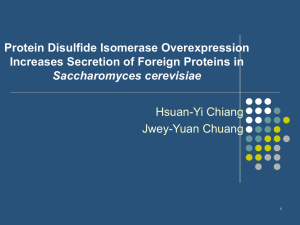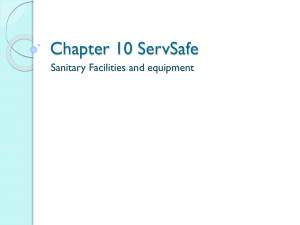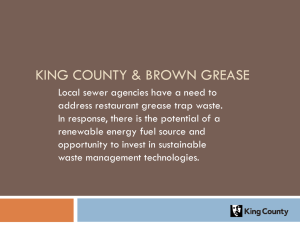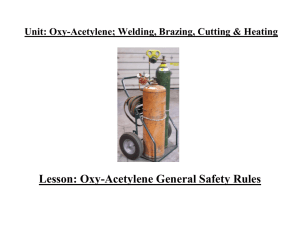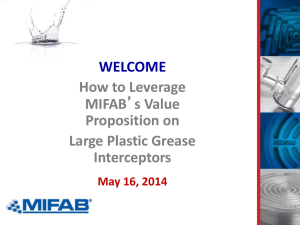grease interceptors - Plumbing & Drainage Institute
advertisement
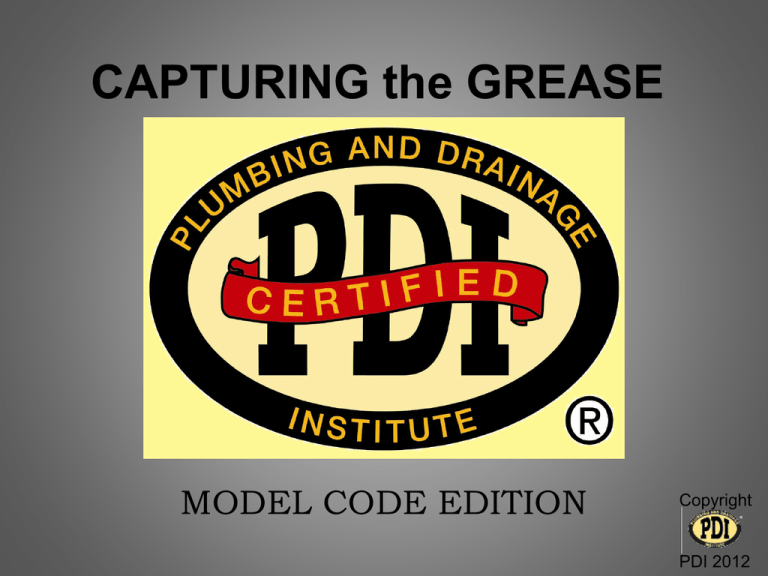
CAPTURING the GREASE MODEL CODE EDITION Copyright PDI 2012 Hydro Mechanical vs Gravity • • • • Grease Interceptors UPC, IPC How they work Sizing Installation • Grease • What it is • Were does it come from • What problems it cause Copyright PDI 2012 Copyright PDI 2012 PDI Plumbing and Drainage Institute The Plumbing and Drainage Institute (PDI) was formed in 1949. The organization developed the original performance requirements and certification program for Grease interceptors (Hydro mechanical Grease interceptors) and Water hammer Arrestors (Shock Arrestors) Copyright PDI 2012 PDI Plumbing and Drainage Institute • • • • Our objective Advancement of Engineered Plumbing Products Research Publish Standards Education Copyright PDI 2012 PDI Plumbing and Drainage Institute • We also participate in the development of the model plumbing codes • UPC, IPC, NSPC Copyright PDI 2012 PDI Plumbing and Drainage Institute • • • • • • • • • • • Ashland Poly Traps Bio-Microbics, Inc. Canplas Industries, Ltd. Green Turtle Americas, Ltd. Jay R. Smith Mfg. Josam Highland Tank/Lowe Engineering L&J Restaurant Inc. Rockford Separators Thermaco Wade Specification Drainage Products/Wade Hydromax® • • • • • • • • • • Watts Water Technologies Zurn Industries Mifab Inc. B K Resources Inc. Klinger’s Trading, Inc. L&J Restaurant Manufacturing Import, Inc. Prima Supply LLC/Atlantic Metalworks Town & Country Plastics Inc. Triton Metals, Inc. Wentworth Company Copyright PDI 2012 PDI Plumbing and Drainage Institute Web Site www.PDIonLine.ORG Copyright PDI 2012 . Copyright PDI 2012 PDI Plumbing and Drainage Institute Publications • PDI G101 Testing and Rating • PDI G102 FOG Sensing and Alarm • Guide to GREASE INTERCEPTORS: Eliminating the Mystery Copyright PDI 2012 . Copyright PDI 2012 Copyright PDI 2012 Grease Interceptor is a generic term representing a family of devices Copyright PDI 2012 Grease Interceptor Definition A plumbing appurtenance or appliance that is installed in a sanitary drainage system to intercept non petroleum fats, oil, and greases (FOG) from a wastewater discharge. Copyright PDI 2012 • Gravity Interceptors • Hydro Mechanical Interceptor Copyright PDI 2012 Copyright PDI 2012 Copyright PDI 2012 Copyright PDI 2012 Copyright PDI 2012 Copyright PDI 2012 Copyright PDI 2012 Copyright PDI 2012 GRD (AGRU) Copyright PDI 2012 Alarm/ Sensing Copyright Automatic Sensor PDI 2012 Copyright PDI 2012 Copyright PDI 2012 Copyright PDI 2012 Copyright PDI 2012 Copyright PDI 2012 Copyright PDI 2012 Copyright PDI 2012 Copyright PDI 2012 Copyright PDI 2012 Copyright PDI 2012 Copyright PDI 2012 Copyright PDI 2012 Copyright PDI 2012 Copyright PDI 2012 • Example 25 GPM Interceptor • Two sinks each at 25 Gallons at 160 F Copyright PDI 2012 • Example 25 GPM Interceptor • Two sinks each at 25 Gallons at 160 F Copyright PDI 2012 • Lard Ratio One Pound/ Five Gallons • Five Pounds of Lard each Run at 160F Copyright PDI 2012 • Min. of 12 Runs per Test • Total Lard min.60 Pounds per Test Copyright PDI 2012 • Min. Retained Lard 56.25 Pounds • Grease removal efficiency 90%-95% Copyright PDI 2012 • Min. Retained Lard 56.25 Pounds • Grease removal efficiency 90%-95% Copyright PDI 2012 • Lard is Skimmed and separated Copyright PDI 2012 • Lard is Skimmed and separated Copyright PDI 2012 • Efficiency = Grease Added - Grease Skimmed Grease added Copyright PDI 2012 Testing and Certification Copyright PDI 2012 Testing and Certification Performance Copyright PDI 2012 Testing and Certification Performance Copyright PDI 2012 Orange County Study Copyright PDI 2012 Copyright PDI 2012 Copyright Automatic Sensor PDI 2012 Grease Interceptor Grease Removal Device (GRD) Any hydro mechanical grease interceptor that automatically, mechanically removes non-petroleum fats, oils and grease (FOG) from the interceptor, the control of which are either automatic or manually initiated. Copyright ASME A112.14.4 PDI 2012 • • • • • Hydro mechanical grease interceptor External grease collection Timer actuated Sensor operated Skim off grease Disc Belt Hydraulic Pump Copyright PDI 2012 Copyright Skimmer / Timer PDI 2012 Copyright PDI 2012 Copyright PDI 2012 • • • • • Hydro mechanical grease interceptor Test PDI G101 Grease separating ASME A12.14.4 Grease removal 150% Removal of Rated capacity, 10 hours FOG removed, Maximum of 5% water Copyright PDI 2012 FOG Disposal System – A grease interceptor that reduces non petroleum fats, oils, and grease (FOG) in effluent by separation, and mass and volume reduction. ASME A112.14.6 Copyright PDI 2012 Copyright PDI 2012 Testing • PDI G101 Grease separation • ASME A112.14.6 Grease Reduction • Discharge water 100mg/liter max. FOG Copyright PDI 2012 Copyright PDI 2012 Copyright PDI 2012 Design criteria for Gravity interceptor, IAPMO Z1001 • Stoke’s Law • 300 Gallon volume minimum • Two chambers 2/3 and 1/3 • Two access point Inlet and outlet • baffle Tee 4” Inlet, outlet above water • Center baffle • length more than width • Air space 9” • Liquid depth 30” min. 6 ft. max • Efficiency 80%-85 % range • Sized by Gallons volume Copyright PDI 2012 Copyright PDI 2012 GRAVITY INTERCEPTOR BEWARE! Copyright PDI 2012 BEWARE! Copyright PDI 2012 Copyright PDI 2012 Copyright PDI 2012 New Definitions • Grease Interceptor • Hydro Mechanical • Gravity • Copyright PDI 2012 • What happened in 2006 to Grease Traps and passive interceptor? • Deleted UPC, IPC 2006 Copyright PDI 2012 Intercepting Grease 2003, 2006 2009 2012 • Trap A fitting or device that provides a liquid seal to prevent the emission of sewer gases without materially affecting the flow of sewage or wastewater through the trap. Copyright PDI 2012 Intercepting Grease IPC Changes Copyright PDI 2012 Intercepting Grease IPC 2003 IPC 2006 IPC 2009 IPC 2012 Copyright PDI 2012 Intercepting Grease IPC 2003 • Grease Interceptor A passive interceptor whose rated flow exceeds 50 GPM. Copyright PDI 2012 Intercepting Grease IPC 2003 • Grease Trap. A passive interceptor whose rated flow is 50 GPM or less. Copyright PDI 2012 Intercepting Grease IPC 2006 2009 • Chapter 2 Definitions • Grease Interceptor (replaces grease interceptor & grease trap) A plumbing appurtenance that is installed in a sanitary drainage system to intercept oily and greasy wastes from a wastewater discharge. Such device has the ability to intercept free-floating fats and oils. Copyright PDI 2012 Intercepting Grease IPC 2012 Chapter 2 Definitions Grease Interceptor Hydro-Mechanical Grease Interceptor. A plumbing appurtenance that is installed in the sanitary drainage system to intercept freefloating (FOG) fats, oils and grease from the wastewater discharge. Continuous separation is accomplished by air entrainment, buoyancy and interior baffles. Gravity Grease Interceptor. A plumbing appurtenance of not less than 500 gallon capacity that are installed in the sanitary drainage system to intercept free-floating (FOG) fats, oils and grease from the wastewater discharge. Separation is accomplished by gravity during a retention time of not less than 30 minute. Copyright PDI 2012 Intercepting Grease IPC 2006 2012 • IPC 1003.3.5 Automatic grease removal devices. (GRD) Where automatic grease removal devices are installed, such devices shall be located downstream of each fixture or multiple fixtures in accordance with the manufacturer’s instructions. The automatic grease removal device shall be sized to pre-treat the measured or calculated flows for all connected fixtures or equipment. Ready access shall be Copyright provided. PDI 2012 Intercepting Grease IPC 2006 2012 • IPC 1003.3.5 Automatic grease removal devices. Copyright Ready access shall be provided. PDI 2012 Intercepting Grease IPC 2006 2012 • IPC 1003.3.4.2 Rate of Flow Controls Shall be equipped with devices to control the rate of water flow. Applies to Hydro-Mechanical only Copyright PDI 2012 Intercepting Grease IPC 2006 2009 2012 Rate of Flow Controls Copyright PDI 2012 Intercepting Grease • IPC 2006 2009 2012 IPC 1003.3.4.1 Grease interceptor capacity Shall have the grease retention capacity Table 1003.3.4.1 Applies to Hydro-Mechanical only Copyright PDI 2012 Intercepting Grease IPC 2006 2009 2012 • IPC 1003.2 Approval • The size, type and location of each interceptor and of each separator shall be designed and installed in accordance with the manufacturer’s instructions ………. Copyright PDI 2012 Intercepting Grease IPC 2006 2009 2012 • IPC 1003.3.2 Food waste Grinders A solids interceptor shall separate the discharge before connecting to the grease interceptor. Applies to all grease interceptors Copyright PDI 2012 Intercepting Grease, IPC 2006, 2012 • IPC1003.3.4 Grease interceptors and automatic grease removal devices Grease interceptors or automatic grease removal devices shall conform to PDI G101, ASME A112.14.3 or ASME A112.14.4 and shall be installed in accordance with the manufacturer’s instructions. Note no size limitation Exception: Volume not less 500 Gallons outside Copyright PDI 2012 Intercepting Grease IPC 2012 • 1003.3.4 Hydro-Mechanical Grease interceptors and automatic grease removal devices (GRD). Grease interceptors or automatic grease removal devices shall conform to PDI G101, ASME A112.14.3 or ASME A112.14.4 and shall be installed in accordance with the manufacturer’s instructions. Note no size limitation Copyright PDI 2012 Intercepting Grease UPC Changes Copyright PDI 2012 Intercepting Grease UPC 2006, Chapter 2 Definitions Grease Interceptor Hydro-Mechanical Grease Interceptor. A plumbing appurtenance that is installed in the sanitary drainage system to intercept free-floating (FOG) fats, oils and grease from the wastewater discharge. Continuous separation is accomplished by air entrainment, buoyancy and interior baffles. Gravity Grease Interceptor. A plumbing appurtenance of not less than 300 gallon capacity that are installed in the sanitary drainage system to intercept free-floating (FOG) fats, oils and grease from the wastewater discharge. Separation is accomplished by gravity during a retention time of not less Copyright than 30 minute. PDI 2012 UPC CHANGE UPC 2003-2006 • What happened to Appendix H ? • New Sizing method Chapter 10 Copyright PDI 2012 Flow Control’s UPC 2006 • 1014.2.1 Each plumbing fixture or piece of equipment connected to a hydro mechanical grease interceptor shall be provided with an approved type of vented flow control installed in a readily accessible and visible location. • No flow-control device having adjustable or removable parts shall be approved Copyright PDI 2012 Grease interceptor Installation General • UPC 1014.1.3 Food Waste Disposal Units and • Dishwashers. Unless specifically required or permitted by the Authority Having Jurisdiction, no food waste disposal unit or dishwasher shall be connected to or discharge into any grease interceptor. Commercial food waste disposers shall be permitted to discharge directly into the building’s drainage system. Copyright PDI 2012 Grease interceptor Installation General • UPC 1014.1.1 Each fixture discharging into a grease interceptor shall be individually trapped and vented in an approved manner. Copyright PDI 2012 Grease interceptor Installation General • UPC 1014.3.2.1 Waste discharge in establishments from fixtures and equipment which may contain grease, including but not limited to, scullery sinks, pot and pan sinks, dishwashers, soup kettles, and floor drains located in areas where grease-containing materials may exist, may be drained into the sanitary waste through the interceptor when approved by the Authority Having Jurisdiction. Copyright PDI 2012 Grease interceptor Installation General • UPC 1014.3.4.1 Each grease interceptor shall be so installed and connected that it shall be at all times easily accessible for inspection, cleaning, and removal of the intercepted grease. A gravity grease interceptor complying with IAPMO Z1001, shall not be installed in any part of a building where food is handled. Location of the grease interceptor shall meet the approval of the Authority Having Jurisdiction. Copyright PDI 2012 Grease interceptor Installation General • UPC 1014.3.4.2 Interceptors shall be placed as close as practical to the fixtures they serve. Copyright PDI 2012 MAINTAINANCE • UPC 1014.1.2 The Authority Having Jurisdiction shall have the authority to mandate the installation of additional equipment or devices and to mandate a maintenance program. Copyright Automatic Sensor PDI 2012 MAINTAINANCE Grease Removal Device Copyright PDI 2012 Copyright PDI 2012 Sizing GREASE INTERCEPTORS •Hydro Mechanical •Gravity Copyright PDI 2012 Defining the Sizing GREASE INTERCEPTORS •Hydro Mechanical ------ GPM •Gravity------ Gallons capacity Copyright PDI 2012 Size Ranges of GREASE INTERCEPTORS Hydro Mechanical ------ GPM 7 to 100 GPM Gravity------- Gallons capacity 500 Gallons and larger Copyright PDI 2012 Sizing GREASE INTERCEPTORS For any type of Grease interceptor drain line flow in GPM must be determined Copyright PDI 2012 Sizing Gravity GREASE Interceptors All interceptors are sized by calculating flow in GPM • • • Drain pipe capacity Actual flow DFU’s Copyright PDI 2012 SIZING Grease INTERCEPTORS Pipe Size Diameter ¼” slope by GPM 2” .025 19.44 3” .025 58.67 4” .025 125.77 5” .025 229.75 6” .025 375.47 Copyright PDI 2012 SIZING Grease INTERCEPTORS by • Fixture type • Fixture size • Fixture quantity • Other equipment Copyright PDI 2012 SIZING Grease INTERCEPTORS by Fixture type • Sinks that are drained… Drain size • Pre rinse……………….... Fixture flow • Food prep……………….. Fixture flow • Cooking equipment….... Drain size • Other equipment………. Rated flow The total= peak flow Copyright PDI 2012 Sizing Gravity GREASE INTERCEPTORS Applying peak GPM flow to Sizing Factor of safety? • 1% of the time flow is at peak • 75%-90% of flows are 1/3 peak Copyright PDI 2012 SIZING Gravity GREASE INTERCEPTORS by GPM FLOW Peak flow GPM X 30 min Gravity Grease Interceptor. A plumbing appurtenance of not less than 500 gallon capacity that is installed in the sanitary drainage system to intercept free-floating (FOG) fats, oils and grease from the wastewater discharge. Separation is accomplished by gravity during a retention Copyright time of not less than 30 minute. PDI 2012 SIZING Gravity GREASE INTERCEPTORS by DFU’S • • • • • • • • • • • • • • • Gravity Grease Interceptor Sizing DFUs Interceptor Volume Pipe size 8 500 gallons 21 (3) 750 gallons 36 1,000 gallons 3”pipe 90 (3) 1,250 gallons 180 1,500 gallons 4” pipe 216 2,000 gallons 307 (3) 2,500 gallons 390 3,000 gallons 5” pipe 428 4,000 gallons 576 5,000 gallons 700 7,500 gallons 6” pipe 2112 10,000 gallons 2640 15,000 gallons Copyright PDI 2012 SIZING Gravity GREASE INTERCEPTORS by DFU’S • If drainage fixture units (DFUs) are not known, the interceptor shall be sized based on the maximum DFUs allowed for the pipe size connected to the inlet of the interceptor. Copyright PDI 2012 Sizing Hydro Mechanical Grease Interceptors All interceptors are sized by calculating flow in GPM • • Drain pipe capacity Actual flow Copyright PDI 2012 SIZING Grease INTERCEPTORS HYDRO MECHANICAL by Pipe Size Diameter ¼” slope GPM 2” .025 19.44 3” .025 58.67 4” .025 125.77 5” .025 229.75 6” .025 375.47 Copyright PDI 2012 SIZING Grease INTERCEPTORS HYDRO MECHANICAL by Actual fixture, sink Step 1 Determine the cubic content of the fixture by multiplying length x width x depth. A sink 48” long by 24” wide by 12” deep Cubic content 48 x 24 x 12 = 13,824 cubic inches Step 2 Determine the capacity in gallons. 1 gal. = 231 cubic inches. Contents in gal. 13,824 = 59.8 gals 231 Step 3 Determine actual drainage load. The fixture is usually filled to about 75% of capacity with waste water. The items being washed displace about 25% of the fixture content. Actual drainage load = 75% of the fixture capacity. Actual drainage load .75 x 59.8 gals. = 44.9 gals. Step 4 Determine the flow rate and the drainage. In general, good practices dictate a one minute drainage period, however where conditions permit , a 2 minute period is acceptable. Drainage period is the actual time required to completely empty the fixture. Flow Rate = Actual Drainage Load Drainage Period Calculated flow rate for 1 minute period Flow rate 44.9 gals. = 44.9 GPM 1 Min. Calculated flow rate for 2 minute period Flow rate 44.9 gals. = 22.5 GPM 2 Min. Step 5 Select the interceptor which corresponds to the flow rate calculated. Note – Select larger size when flow rate falls between two sizes listed. If the flow rate is above 50 GPM, select a larger interceptor. For 1 minute period 44.9 GPM For a 2 minute period 22.5 GPM Copyright PDI 2012 SIZING Grease INTERCEPTORS HYDRO MECHANICAL by Actual fixture • Pre rinse…………………Fixture flow • Food prep………………..Fixture flow • Cooking equipment…....Drain size • Other equipment……....Rated flow • Actual sink capacity@ one/two minute Note: Sink drain by Manning may have lower flow The total= peak flow Copyright PDI 2012 Sizing Hydro Mechanical Grease Interceptors GPM peak flow =GPM size Interceptor Note: flow control limits sink GPM Hydro-Mechanical Grease Interceptor. A plumbing appurtenance that is installed in the sanitary drainage system to intercept free-floating (FOG) fats, oils and grease from the wastewater discharge. Continuous separation is accomplished by air entrainment, buoyancy and interior baffles. Copyright PDI 2012 SIZING GREASE INTERCEPTORS Under sizing can be a problem • Increased drain down time • More frequent cleaning Copyright PDI 2012 SIZING GREASE INTERCEPTORS Over sizing can be a problem • Grease Breaks down • Increased cleaning cost Low Water exchange pump truck size Copyright PDI 2012 Polar Hydrocarbon Free fatty acids. Glycerin Copyright PDI 2012 FOG breaks down into Fatty acids and Glycerin Hydrolisis Microbes Chemicals Copyright PDI 2012 Fatty acids Harden with Iron oxide Chemically bond to pipes Fatty acids are corrosive Saturated fatty acids reacting with Calcium forming a solid tacky substance Copyright PDI 2012 Harden with Iron oxide Chemically bond to pipes Copyright PDI 2012 Saturated fatty acids reacting with Calcium forming a solid tacky substance Copyright PDI 2012 FOG/Food breaks down Copyright PDI 2012 Over sizing Increased cost of cleaning Over sizing encourages less frequent cleaning Less water exchange, septic conditions, low Ph. Copyright PDI 2012 FOG/Food breaks down Sulfur reducing anaerobic bacteria Hydrogen sulfide Symbiotic aerobic bacteria Sulfuric acid Copyright PDI 2012 HOW THEY WORK Copyright PDI 2012 .A plumbing appurtenance that is installed in the sanitary drainage system to intercept free-floating (FOG) fats, oils and grease from the wastewater discharge. Continuous separation is accomplished by air entrainment, buoyancy and interior baffles. . A plumbing appurtenance of not less than 500 gallon capacity that are installed in the sanitary drainage system to intercept free-floating (FOG) fats, oils and grease from the wastewater discharge. Separation is accomplished by gravity ( buoyancy ) during a Copyright retention time of not less than 30 minute. PDI 2012 Copyright PDI 2012 Copyright PDI 2012 Copyright PDI 2012 Gravity Grease Interceptors Copyright PDI 2012 Copyright PDI 2012 Copyright PDI 2012 Special applications (Multi-ceptor) Copyright PDI 2012 Copyright PDI 2012 Copyright PDI 2012 Vented Flow Control Copyright PDI 2012 FLOW CONTROL At a level of 18”-36” below the fixture. Between the fixture and Grease Interceptor One flow control per Grease Interceptor Copyright PDI 2012 GREASE REMOVAL DEVICE “GRD” Skimmer / Timer Copyright PDI 2012 GREASE REMOVAL DEVICE “GRD” Copyright PDI 2012 GREASE REMOVAL DEVICE “GRD” Copyright PDI 2012 FOG Disposal System A grease interceptor that reduces non petroleum fats, oils, and grease (FOG) in effluent by separation, and mass and volume reduction. ASME A112.14.6 Copyright PDI 2012 FOG DISPOSAL SYSTEM Copyright PDI 2012 • • • • • • • • • • Standards • Flow • Min. Size • Flow control • Vent • Grinders • Certification • Location • Cleaning • Yes • Any No Yes Yes No Yes Any Empty Yes Any • • • • • • • 300 No No No Yes Outdoors Empty Copyright PDI 2012 Copyright PDI 2012 Copyright PDI 2012 Copyright PDI 2012 Copyright PDI 2012 Copyright PDI 2012 Copyright PDI 2012 Copyright PDI 2012 Copyright PDI 2012 Copyright PDI 2012 Copyright PDI 2012 Copyright PDI 2012 Copyright PDI 2012 Copyright PDI 2012 Copyright PDI 2012 Copyright PDI 2012 • • • • • General No Garbage/ food grinder directly connected Avoid high detergent fixtures Easy access for cleaning Check for correct AHJ Check for local required interceptor designs Copyright PDI 2012 General • Avoid distances of greater than 25 ft • Gravity and Hydro can be used together • Gravity installed outside of building Copyright PDI 2012 • • • • • • • • • • Standards • Flow • Min. Size • Flow control • Vent • Grinders • Certification • Location • Cleaning • Yes • Any No Yes Yes No Yes Any Empty Yes Any • • • • • • • 300 No No No Yes Outdoors Empty Copyright PDI 2012 Copyright PDI 2012 •New Awareness •Clean Water Act •Regulations •Research •Technology available •Design considerations Copyright PDI 2012 New Awareness Copyright PDI 2012 What problems it cause ? SSO Sanitary Sewer overflows "SSO", are a violation of the Federal Clean Water Act. These SSO’s have resulted in millions of dollars in fines by the EPA Copyright PDI 2012 SSO Sanitary Sewer overflows Copyright PDI 2012 SSO Sanitary Sewer overflows Copyright PDI 2012 SSO Sanitary Sewer overflows In Orange County, CA, 252 orders have been issued, closing beaches for more than 2000 days (from 1987 through 2000). The majority of these closures were the result of bacterial contamination from sewage spills flowing into the ocean, usually originating from sewer lines clogged with grease. This is almost 6 years of closure. Copyright PDI 2012 SSO Sanitary Sewer overflows SSO Sanitary Sewer overflows 2006 EPA has reported in monitoring 35 States there were 40,000 beach day closings in the year 2006, due to contamination. Copyright PDI 2012 SSO Sanitary Sewer overflows Los Angeles County Sanitation Districts are fined $4.6 million for January 2006 sewage spill. Agreed to a $2.5 million settlement and released from liability for 93 sewage spill over the previous five years. Copyright PDI 2012 SSO Sanitary Sewer overflows • Connecticut • 1999-2003 • 2200 SSO’s Copyright PDI 2012 SSO Sanitary Sewer overflows Regulations • State • Plumbing Code • Public Health Code • POTW • City Copyright PDI 2012 SSO Sanitary Sewer overflows Enforcement • AHJ • BY State • Within the State • BY Sewer Company Copyright PDI 2012 SSO Sanitary Sewer overflows • Studies • Orange County FOG Control 2005 • NC State Project FROG 2007 Copyright PDI 2012 SSO Sanitary Sewer overflows Copyright PDI 2012 SSO Sanitary Sewer overflows Copyright PDI 2012 SSO Sanitary Sewer overflows Orange County Study Copyright PDI 2012 SSO Sanitary Sewer overflows Orange County Copyright PDI 2012 SSO Sanitary Sewer overflows • NC State Project FROG 2007 FOG blockages are the primary cause in 40% to 50% of all SSO’s (Southerland,2002) Another 10% to 25% are roots and grease Copyright PDI 2012 SSO Sanitary Sewer overflows • NC State Project FROG 2007 50% to 75% Copyright PDI 2012 • • • • • • • • Were does it come from Food preparation and clean up Schools Assisted Living Nursing homes Hospitals Amusement Parks Malls Restaurants Copyright PDI 2012 How much? • • • • Cafeteria 4,500 mg/L Chinese 1,900 mg/L Italian 1,000 mg/L American 950 mg/L Copyright PDI 2012 New Awareness Reference / Information Water Environment Research Foundation www.WERF.org Plumbing and Drainage Institute www.PDIonLine.org Copyright PDI 2012 Myths and Facts Copyright PDI 2012 • Myth: If grease is not used in food preparation a grease interceptor is not needed • Fact: Grease is not the only problem. The overall problem is FOG . (Fats, oils and grease). These materials alone or in combination will result is sewer blockages Copyright PDI 2012 • Myth: If food is not prepared on site a grease interceptor is not needed • Fact: A stove is not the source of FOG, it is the sink. Containers and utensils can be a significant source of FOG Copyright PDI 2012 • Myth: Grease interceptors only retain FOG • Fact: In addition to FOG grease interceptors will capture food solids. Copyright PDI 2012 • Myth: Choosing a larger size grease interceptor will result in a greater grease removal efficiency. • Fact: When grease interceptor has been sized properly to the anticipated maximum flow using a grease interceptor with a larger flow capacity will not increase grease removal efficiency. Copyright PDI 2012 • Myth: The larger the grease storage capacity the more efficient the interceptors grease removal. • Fact: Grease must be separated from the waste water before it can be stored. Storage capacity and grease removal efficiency are not related. Copyright PDI 2012 Myth: The grease must cool and harden to separate from the waste water. • Fact: Grease interceptors separate based on the difference in specific gravity of FOG and water. Liquefied grease floats just as well as solidified grease. Grease is lighter than water. Copyright PDI 2012 • Myth: Hot water will melt the captured grease and wash the grease through the interceptor • Fact: All hydro mechanical grease interceptors are tested for grease removal efficiency with 150°F water. Copyright PDI 2012 • Myth: Low temperature dish washers can connect to the grease interceptor. • Fact: All dishwashers can be problematic. It is not the temperature but the soaps, detergents and sanitizers that emulsify the FOG. Copyright PDI 2012 • Myth: It is important to connect floor drains to the grease interceptor. • Fact: Floor drains are not usually a significant source of FOG. Drain cleaners and strong cleaning agents used on floors can emulsify FOG already captured in a grease interceptor. Copyright PDI 2012 • Myth: Once the grease is captured in the interceptor, it will remain captured in the interceptor as long as the interceptor is not yet 25% full. • Fact: Because the grease (FOG) is contaminated with food particles and the interceptor is a breeding ground for bacteria, the FOG can be broken down, exit the interceptor and create blockages downstream. Copyright PDI 2012 • Myth: Over sizing an interceptor cannot hurt. • Fact: Over sizing an interceptor relative to actual flow is a problem. It can result in the generation of hydrogen sulfide gas that can convert to an acid. Both metal and concrete structures downstream have suffered severe structural damage from this acid. Copyright PDI 2012 • Myth: When the grease interceptor is full, the drain line will stop flowing. • Fact: Water will continue to flow even when the FOG in the interceptor is at capacity. Additional grease in the wastewater will simply flow right through the interceptor. Grease interceptors must be either manually or electronically monitored. Copyright PDI 2012 • Myth: With the change to healthier cooking oils, there is less of a FOG problem. • Fact: Cooking oils that are healthier for you are no healthier for the drainage system. They are all polar hydrocarbons. In fact, some of the new alternative cooking oils with specific gravities closer to water will be harder to capture from the Copyright wastewater. PDI 2012 • Myth: A clogged drain and clean out is the worst that can happen. • Fact: FOG can can cause extensive sewer failure and costly repairs. Copyright PDI 2012 Copyright PDI 2012 • Myth: Grease does not clog plastic pipe • Fact: FOG can create blockages in all drain pipe materials. Copyright PDI 2012 Copyright PDI 2012 THANK YOU Copyright PDI 2012
